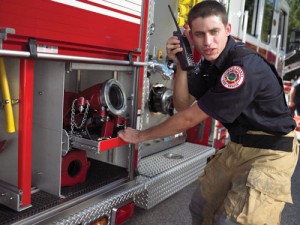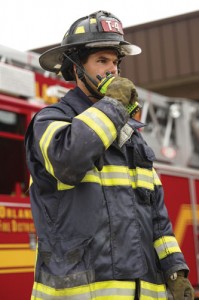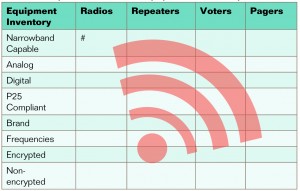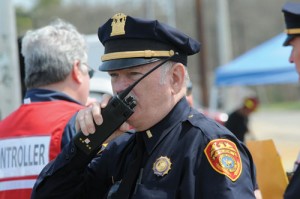On Your Watch

At a workshop in January, the FCC reaffirmed that it has no intention of extending the compliance deadline of Jan. 1, 2013. (Photo Kenwood USA)
By Ron Haraseth
It was 1995. I authored a state public safety communications newsletter with background information on narrowbanding from the Federal Communications Commission (FCC). At the time, it was called refarming. A quick look in my file cabinet at those old newsletters indicated the original dates for operational conversion were much more aggressive than the current deadline. The 12.5 kHz date was listed as Jan. 1, 1997, to retain primary status on existing licensed channels. Zoom forward, and with much interim discussion, we are looking at a deadline of Jan. 1, 2013. (More key deadlines.)
The original FCC Notice of Proposed Rulemaking (NPR) had many other interesting aspects, most of which have been drastically altered as well and for good reason. However, the fundamental reason behind that now ancient document still stands today—to increase spectrum efficiency.
The FCC’s ultimate goal is for 6.25 kHz or equivalent emission. However, the Commission has not yet set a date by which this must occur.
So where do you and your agency stand? Considering this issue has been on notice for 16 years, there is little excuse for ignorance. Yet ignorance remains.
I have to think the remaining ignorance is due to the inherent nature of public safety’s management structure. Public safety agencies experience a changing management structure. It is something I have often discussed with my colleagues, and I myself have experienced over my nearly 40 years of working in the public sector. It’s simply that there’s a requirement about every two years to reeducate upper management. This includes elected officials, as well as normal management professionals and uniformed officers.
The uniformed services suffer greatly because many of the managers in the law enforcement and fire fields are professionals in their respective fields, not in telecommunications. These professionals often rotate responsibilities or are promoted into and out of telecommunications management positions. The end result is a continual requirement for reeducation.
All too often the response of those that have been aware of the narrowbanding issues is, “It won’t happen on my watch so why should I get excited?” leaving the response—and responsibility—to some future system manager.
The Time Is Now
Does narrowbanding affect you and your agency? If your public safety radio system uses frequencies in the bands 150–174 MHz and 421–512 MHz ranges then you are affected. Public safety is allocated spectrum that’s regulated by the FCC under Section 47CFR (Code of Federal Regulations). Subsection Part 90 outlines the specific technical requirements for public safety radio licensees. With only a few exceptions for Part 90 frequencies listed and allocated exclusively for paging, all other frequencies are subject to the narrowbanding requirements. If you are paging on frequencies not specifically noted as exempt as paging channels, then they also are subject to narrowbanding.
Have you already converted to a digital system, such as P25? If that’s the case, then you are already compliant and operating in narrowband. All current digital systems are in compliance with the narrowband mandate. But even if you have converted to digital and you maintain backward analog compatibility, these too will need to be modified.
If you are maintaining a mobile data system transmitting data exclusively on a dedicated channel, you may be able to retain your license for that operation as long as your system complies with the effective efficiency requirement. Data systems must be able to transmit a minimum of 19.2 kbps (kilo bits per second) within a 25 kHz channel.
For those few operating in the VHF low band (30–50 MHz) or the many others above 512 MHz, such as 800 MHz, then you don’t have to narrowband your equipment. (Note: 700 MHz already requires a minimum 12.5 kHz efficiency.) But should you share daily operations or special events with other agencies and if you maintain radios to communicate with agencies that are subject to narrowbanding, then you will be affected. Any equipment you use that operates on an adjoining agency’s system subject to narrowbanding must also be narrowbanded. This may be equipment provided to you from the adjoining agency or perhaps equipment that is part of your portable emergency cache equipment.
Talk with your personnel responsible for maintaining your emergency response equipment, including mobile command vehicles and any portable cache equipment. You’ll need to coordinate any technical changes with other agencies to ensure continuous communications. In most such instances, you’ll be operating on the adjoining agency’s license through a mutual aid agreement/document. Be sure you have formal authorization from the adjoining agency and operate under the technical restrictions of their FCC license, including power limitations and area of operating authorization. The adjoining agency will be responsible for altering their FCC license to reflect the narrowband requirement. (See “Implementation Tips,” below.)
License Modification
Prior to operating in a narrowband mode, you must submit a modification to your FCC license reflecting the narrowband emission change. However, you must ascertain the correct narrowband emission designation, which may vary depending on the technology you are using. Is the system analog or digital? If digital, the type of digital modulation may reflect differently depending on the mode in use. There may be multiple modes, and the FCC licensing system can accommodate multiple emission designators.
Each make and model radio is required to have “type acceptance” certification from the FCC, which includes the authorized emission designators for each radio. The manufacturer can provide you with the correct emission designator dependent on the make and model of the equipment and the use of the radio. (There may be multiple type-accepted emission designators for any given model of radio.)

Don’t forget your cache radios, transportable systems, radios installed in command post and communications vehicles. (Photo Motorola Solutions)
To accommodate a transition period, the original wideband emission designators can be left active on the license and removed later on after the physical conversion. The required emission designator changes can be done directly online by your staff on the FCC ULS (Universal Licensing System). This should be attempted only by internal staff personnel who are fully familiar with the requirements of the FCC licensing system and the technical change required. Normally, the FCC ULS system will only allow a licensee to alter administrative information such as contact information. The FCC has temporarily altered the ULS system to allow this single technical change of adding/changing an additional 12.5 kHz analog emission designator. You may maintain your existing emission designators and add the new designator. After conversion, you will remove the older wideband designator.
Any license technical changes, including adding/changing an additional 12.5 kHz or 6.25 kHz digital emission designator, must be submitted to the FCC through the services of one of the four recognized public safety frequency coordinators.
If you are at all unsure of the process, then it is highly recommended you use the services of the frequency coordinators. All four coordinators have established a very significant discount for merely altering the emission designator on a license to reflect the required narrowband changes and will work closely with you to ensure it is done correctly.
APCO International’s Spectrum Management Division is the largest of the four frequency coordinators and can provide any assistance required. This is a good time to review your license for any other technical irregularities or other required corrections to ensure your license does indeed match your physical system. Should you use a frequency coordinator, they will help you review your license for other irregularities. (For more information specific to licensing, read “Check Your License” by Chris Kindelspire.)
Consequences of Failing to Act
Your license is a critical document. It provides your direct authorization to transmit on the system that is your primary lifeline to your field personnel. Should you elect to ignore the deadline, the FCC may not be the pussycat you might expect. The FCC routinely issues fines and forfeitures for licensing and operational issues.
From the FCC’s narrowbanding information website: “After Jan. 1, 2013, licensees not operating at 12.5 kHz efficiency will be in violation of the Commission’s rules and could be subject to FCC enforcement action, which may include admonishment, monetary fines, or loss of license.”
Some agencies believe they can rely on waiver requests to delay the impending narrowband date, but all indications point to an FCC that will turn deaf ears to any such requests.
In fact, the FCC has stated that “it will take any non-compliant systems off the air after the deadline or assess federal penalties, including fines. Additionally, the FCC will begin refarming the new 12.5 kHz channels created by narrowbanding, which could result in interference with any wideband channels still in operation.”[1]

Table 1: Sample Narrowband Equipment Inventory (Source: Department of Homeland Security, Office of Emergency Communications.)
Take Inventory
After your license has been modified, you are authorized to operate in narrowband mode. Sounds simple, and it may be. Virtually all equipment purchased within the past 10–15 years was manufactured to operate in a narrowband mode. A simple programming change may be all you need, but even that option may have complications that need to be addressed. There’s no magic switch that can instantly convert all equipment. It will take contact with each and every single device, including base stations, mobile and portable equipment.
The first step in any narrowband effort will be a full inventory and audit of all equipment (see Table 1, above right, and checklist below). Each device will probably require a unique approach and therefore identifying the technical requirements of each different model of equipment is necessary. The location of each piece of equipment is critical. An effective plan will take into account the location, make/model and availability of equipment involved, including the ones that are lost in desk drawers until the next time they get used. Are there any devices owned by other agencies who you allow to operate on your system? These must be coordinated as well.
You may also wish to review our listing of manufacturers and their narrowband-compliant equipment.
To Move or Not to Move
Many agencies are using the narrowband requirement as an opportunity to upgrade their systems. If you’re considering a move to digital, this may be the right time. This, of course, requires an entire system change of all equipment, including base station, mobile and portable equipment. Funding and all other planning considerations must be considered in order to physically complete the change by the Jan. 1, 2013, deadline.
Planning should include an analysis of coverage regardless of whether you may be staying with a conventional analog narrowband system or converting to digital. Generally accepted engineering practices, along with some anecdotal information, point to some loss of coverage when converting from wideband analog to narrowband analog. This may translate to a loss of signal if your current wideband operation is already marginal in certain critical areas. Physical comparative testing is the best way to verify coverage. Narrowband analog may require a reconfiguration of your base station network, which may consist of upgrading antennas, but may also require additional radio sites.

Narrowbanding will require contact with every single device, including base stations, mobile and portable radios. (Photo Craig Jackson/www.inthedarkphotography.com)
Digital narrowband systems may result in some loss of area, but some agencies report minimal loss if any. This may be due to the ability of digital to process signals making up for reduced signal energy resulting from a narrower emission mask. Again, the best way to judge is to run a series of comparative tests. It is best to be prepared and plan for any change requirements prior to a final cutover.
A complex web of interoperability may be your biggest challenge. Interoperability is a key element leading to successful response for emergency incidents, as well as routine daily interaction with adjoining or co-located agencies. Well prepared agencies will have agreements with associate agencies within their region in the form of mutual aid agreements, state or regional interoperability plans, or some other manner of standard operations procedures. This will require preplanning efforts to ensure there’s no loss of communications capabilities during all phases of narrowband implementation. A check on the status of your current plans and documents is in order. A conversion strategy should address and include all of the agencies with whom you work on a routine basis. It’s typical for agencies to authorize others to access their system resulting in a requirement for an integrated approach between many entities.
Similarly, there may be a heavy reliance on dedicated interoperability channels. Some of these channels may be licensed by “Rule,” which means the FCC has given blanket authorization for their use for agencies that have an active FCC license to operate on other routine public safety frequencies. These will not require a licensing change for mobile use of these specific frequencies, but if they are used at a specific fixed location as a base station on a license, they will require a license modification.
Myth or truth? You are required to change channels—No. You are required to move to 800 MHz—No. You are required to go digital—again, No. These may be options, but they are not part of the FCC’s plan for narrowbanding. Few agencies have financial resources to make a significant change in their radio system. Therefore, it’s imperative that all possible avenues be thoroughly investigated, including the simplest.
Broadband Connection
With the impending National Broadband Network effort, there has been some speculation that wireless broadband will provide an alternative to conventional voice land mobile radios. Although there’s a lot of potential in this direction, the timing is simply not there.
Land mobile voice radio has been identified as the most critical component of public safety communications. Many agencies are already using broadband wireless through leased access from one of several commercial broadband networks. Thus far, these systems only provide data-oriented service, not routine voice and specifically not voice meeting the mission critical status of land mobile radio. Even the developmental systems currently being anticipated by several agencies around the country do not have the ability to support critical voice capability. These systems may be able to supplement and even augment existing land mobile voice systems, but should not be relied on at this time for primary voice operations. It will take some time before broadband wireless will be able to effectively replace the capabilities of land mobile radio — certainly well beyond the FCC deadline of Jan. 1, 2013.
Learn More
There are a number of online information sources for narrowbanding beginning with APCO’s Spectrum Management front website: www.apcointl.org/frequency. And the FCC’s own site: http://transition.fcc.gov/pshs/public-safety-spectrum/narrowbanding.html.
Exercise due diligence, and start your homework.
About the Author
Ron Haraseth is a longtime APCO International member with 39 years of experience in the field of public safety radio, including nine years as the director of APCO’s Frequency Coordination Program.
Reference
1. Department of Homeland Security, Office of Emergency Communications. A Practical Guide to Narrowbanding. March 2011.
Sidebar: Key Deadlines
As of Jan. 1, 2011, the FCC no longer accepts applications for new wideband 25 kHz operations or expansion of existing wideband 25 kHz operations.
By Jan. 1, 2013, all non-federal FCC licensees operating on the VHF and UHF bands must use 12.5 kHz (11.25 kHz occupied bandwidth) or narrower channels or use technology that achieves the narrowband equivalent of one voice channel per 12.5 kHz of channel bandwidth or a data rate of at least 4,800 bits per second per 6.25 kHz.
As of Jan. 1, 2011, no new 150–174 MHz or 421–512 MHz wideband equipment may be certified. Production and sale of existing models may continue until Jan. 1, 2013.
After Jan. 1, 2013, all 150–174 MHz or 421–512 MHz band equipment over 2 watts certified in the U.S. must be capable of super narrowband transmissions (6.25 kHz).
Source: Department of Homeland Security, Office of Emergency Communications. A Practical Guide to Narrowbanding. March 2011.
Sidebar: Implementation Tips
By Farokh Latif, director, APCO AFC
- Check your call signs.
- Conduct a full radio inventory.
- Determine what equipment can be reprogrammed and what must be replaced.
- Secure a budget for all related services and equipment.
- Develop a wideband-to-narrowband system conversion plan that addresses the replacement and installation of radios and base stations, and the actual radio reprogramming.
- Work closely with your two-way radio supplier.
- Schedule and coordinate the system conversion.
- Account for shared frequencies (interoperability channels).
- Remove wideband emission from your license(s).
Don’t Count on a Waiver: According to APCO AFC Director Farokh Latif, if you plan to apply for a waiver, you must have a really good reason and need to show some progress toward reaching compliance when you apply, as well as address interoperability with neighboring agencies that have already completed narrowbanding.
Sidebar: How to Conduct a Radio Inventory
By Gary L. Oldham
Planning
- Determine the scope of the inventory.
- Determine database elements to collect.
- Determine sites for physical inventory.
- Determine if a Web-based inventory is needed as a primary or adjunct tool.
- If so, create in-house or secure from vendor/consultant.
Logistics
- Set up database.
- Determine inventory team.
- Determine radio reading/programming software needs.
- Ensure database template & radio software are installed on laptop(s) to be used for the inventory and that all necessary cables are provided to the inventory team.
- Coordinate, schedule and publicize visits in advance.
- Coordinate as needed with outside vendors or site owners/tenants for radio site access.
Operations
- Make inventory visits.
- Update database.
- Schedule revisits as necessary or augment with Web-based inventory tool.
Post-Inventory Assessment
- Assess success.
- Determine if any data gaps exist, take remedial steps to collect missing data.
- Develop policy for maintaining currency, distribute policy to all radio users.
Future Planning
- Identify radios that need near-term firmware updates, reprogramming or replacement.
- Identify longer-term replacement/upgrade needs.
- Identify ongoing aging/replacement plan and schedule.
- Begin budget process, backed up by current, valid data.
Originally published July 2011 in Narrowband Now: Strategies for Meeting the Jan. 1, 2013, Deadline, a supplement to APCO International’s Public Safety Communications sponsored by Aeroflex Inc., Kenwood USA Corp., Motorola and Simulcast Solutions LLC.
Related Stories
- “Check Your License: Operating a Radio with an Expired License Can Get You Fined or Knocked Off the Air,” by Chris Kindelspire
- “‘Unfunded Mandate’: How to Fund Your Narrowbanding Project,” by Charles Taylor & Keri Losavio
- “Narrowband Migration: Lessons Learned & Best Practices,” by Keri Losavio, with additional reporting by Teresa McCallion
- Frequently Asked Questions about Narrowbanding


